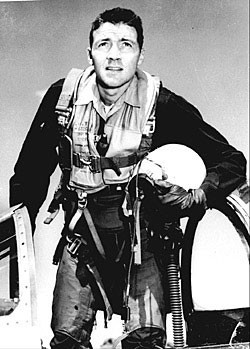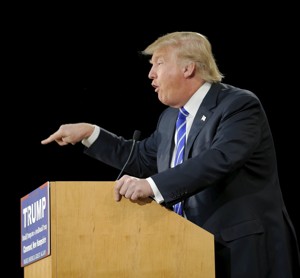
This article, “A Military Strategist Explains Why Donald Trump Leads and How He Will Fail,” is more than three weeks old. But I just saw it today, thanks to reader Seth K; and it stands up better and is more forward-looking than most of what you’re reading now about the race.
The author, a lawyer and RedState contributor named Dan McLaughlin, bases his analysis of the GOP field on a long-time favorite source of my own: the fighter pilot and military strategist John Boyd, shown in the photo as he looked during the Korean War. I first met Boyd in the late 1970s, (thanks to an introduction from the military historian William Lind, then working for Sen. Gary Hart) when reporting an Atlantic article called “The Muscle-Bound Superpower” and my book National Defense. I remained in close touch with Boyd after that. Here are a few previous items about him, with links to others: a brief appreciation after his death in 1997; a description of his concept of the “OODA Loop” from last year; and a note about how he would have viewed the Iraq war, from 2008.

Boyd’s most influential legacy is probably that of the “OODA Loop,” which essentially means staying a beat ahead of your adversary in the decision-action cycle. By the time the other side makes a move, you’ve already anticipated it; when you make the next move, you take them by surprise. The concept has ramifications in fighter-plane combat (which is how Boyd originally developed it), in business competition (Boyd became fascinated by Toyota’s fast-cycle manufacturing process), and in sports (after I wrote about Boyd long ago, I got an out-of-the-blue note from Bill Walsh, then just beginning his run as 49ers coach, saying that he wanted to get in touch with Boyd).
And, as this latest article shows, it applies in politics. McLaughlin gives a thorough explanation of the Boyd concept of out-witting and out-maneuvering the adversary, rather than outmuscling him, and then applies it to this year’s GOP race.
Here are two illustrations of how he extends the logic:
1. Ambiguity
A crucial concept in Boyd’s work is ambiguity. An opponent who wishes to counter your approach will want to ascertain your intentions, capabilities, and movements, and respond accordingly. It becomes much more difficult to do this if you are able to keep your intentions and actions unclear to the opponent for as long as possible….
Given his long and erratic history, loose party loyalty, and propensity to bluff, Trump’s competitors for the 2016 Republican presidential nomination were quite reasonably conditioned to view talk of a Trump 2016 campaign, and even his June 16 announcement, with uncertainty: was it another publicity stunt? A run-up to a Perot-style third party campaign? A stalking horse for some hidden agenda? A personal vendetta against Jeb Bush? Or a real effort to win the Republican nomination?
Unable to discern Trump’s intentions in May, June, and July, his opponents were tentative in reaching decisions and putting them into action. To the extent that he maintains the third-party threat to this day, it provides him a screen of ambiguity that protects him against attacks other candidates would have to face.
2. The power of mental models
Boyd stressed that much of the OODA process occurs beyond conscious thought, and draws on things like reflex, training, memory, cultural background, and personal experience. This is most obvious in Boyd’s concept of orientation as a process that filters observations and tends to fit them into pre-existing “mental models”….
As Boyd would predict, personal history formed the mental models that figured into the candidates’ assessments of the third-party threat. For Jeb Bush, 1992 had to loom large: a populist billionaire fond of ranting against trade with Mexico barges into the race as a third-party candidate, splitting off the Buchananist chunk of the GOP base and handing a national election from the Bush family to the Clinton family.
So, from the outset, Jeb was conditioned to fear a Trump third-party run as a larger threat than a Trump run as a Republican. In the early going, therefore, Jeb’s natural orientation was to back away from conflict that might further antagonize Trump.
Three GOP contenders—Marco Rubio, Rick Perry, and Chris Christie—had a different history. All three had faced down third-party challenges and won… Perry had also survived a moderate primary challenge in 2010, but in 2012 he lost to the establishment favorite, Mitt Romney, in part because Perry was blindsided by attacks from his right (mainly by Michele Bachmann) on immigration.
It was therefore Perry—predictably, in hindsight—who disregarded Trump’s shield of ambiguity, seeing him as a threat to be neutralized no matter what he was up to, and moved first against Trump in August.
There is much more in the piece, including why, according to McLaughlin, the same Boyd maxims doom Trump to longer-term failure. I love this comparison:
In some ways, Trump’s situation in the summer and fall of 2015 is similar to that of Imperial Japan in late 1941 and early 1942. The Japanese ran wild for six months after Pearl Harbor, using speed, strategic and tactical surprise, and sudden, overwhelming force to disorient their opponents and change their surrounding reality faster than they could react.
They also compelled their adversaries—in the short run—to fight the kind of war the Japanese had spent the previous 36 years planning for. The result took the weakest combatant (the Dutch) completely out of the fight, drove most distant and thus slowest to replenish its forces (the British Navy) out of the theater, and sent the locals underground (the Filipinos) or deeper into their interior (the Chinese).
But the Japanese didn’t apply Boyd’s OODA cycle as an open loop from which they could learn and adapt. They just came in with a cast-in-stone pre-existing skillset that was spectacularly well-suited to their initial offensive. They operated inside the enemy’s Loop, but without tending to their own, which remained mostly closed.
Very much worth reading, and using as a prism through which to watch the evolving horse-race news. Thanks to Dan McLaughlin for writing it and to Seth K for the tip.